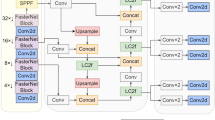Abstract
Recently, the advancements of Internet-of-Things (IoT) have expanded its application in underwater environment which leads to the development of a new field of Internet of Underwater Things (IoUT). It offers a broader view of applications such as atmosphere observation, habitat monitoring of sea animals, defense and disaster prediction. Data transmission of images captured by the smart underwater objects is very challenging due to the nature of underwater environment and necessitates an efficient image transmission strategy for IoUT. In this paper, we model and implement a discrete wavelet transform (DWT) based deep learning model for image compression in IoUT. For achieving effective compression with better reconstruction image quality, convolution neural network (CNN) is used at the encoding as well as decoding side. We validate DWT–CNN model using extensive set of experimentations and depict that the presented deep learning model is superior to existing methods such as super-resolution convolutional neural networks (SRCNN), JPEG and JPEG2000 in terms of compression performance as well as reconstructed image quality. The DWT–CNN model attains an average peak signal-to-noise ratio (PSNR) of 53.961 with average space saving (SS) of 79.7038%.











Similar content being viewed by others
References
Perera, C., Liu, C.H., Jayawardena, S.: The emerging internet of things marketplace from an industrial perspective: a survey. IEEE Trans. Emerg. Top. Comput. 3(4), 585–598 (2015)
Domingo, M.C.: An overview of the internet of underwater things. J. Netw. Comput. Appl. 35(6), 1879–1890 (2012)
Pascual, J., Sanjuan, O., Cueva, J.M., Pelayo, B.C., Alvarez, M., Gonzalez, A.: Modeling architecture for collaborative virtual objects based on services. J. Netw. Comput. Appl. 34(5), 1634–1647 (2011)
Union, I.T.: The Internet of Things—Executive Summary. ITU Internet Reports (2005)
Cui, J.-H., Kong, J., Gerla, M., Zhou, S.: The challenges of building mobile underwater wireless networks for aquatic applications. IEEE Netw. 20(3), 12–18 (2006)
Liu, L., Zhou, S., Cui, J.-H.: Prospects and problems of wireless communications for underwater sensor networks. Wiley Wirel. Commun. Mob. Comput. 8(8), 977–994 (2008)
Uthayakumar, J., Vengattaraman, T., Dhavachelvan, P.: A new lossless neighborhood indexing sequence (NIS) algorithm for data compression in wireless sensor networks. Ad Hoc Netw. 83, 149–157 (2019)
Ghanbari, M.: Standard codecs: Image compression to advanced video coding. IET Telecommunication Series (2003)
Zhai, G., Zhang, W., Yang, X., Lin, W., Xu, Y.: Efficient image deblocking based on postfiltering in shifted windows. IEEE Trans. Circuits Syst. Video Technol. 18(1), 122–126 (2008)
Foi, A., Katkovnik, V., Egiazarian, K.: Pointwise shape-adaptive dct for high-quality denoising and deblocking of grayscale and color images. IEEE Trans. Image Process. 16(5), 1395–1411 (2007)
He, K., Zhang, X., Ren, S., Sun, J.: Deep residual learning for image recognition. arXiv preprint arXiv:1512.03385 (2015)
Duchi, J., Hazan, E., Singer, Y.: Adaptive subgradient methods for online learning and stochastic optimization. J. Mach. Learn. Res. 12, 2121–2159 (2011)
Zeiler, M.D.: Adadelta: an adaptive learning rate method. arXiv preprint arXiv:1212.5701 (2012)
Kingma, D., Ba, J.: Adam: a method for stochastic optimization. arXiv preprint arXiv:1412.6980 (2014)
Dong, C., Loy, C.C., He, K., Tang, X.: Image super-resolution using deep convolutional networks. IEEE Trans. Pattern Anal. Mach. Intell. 38(2), 295–307 (2016)
Toderici, G., O’Malley, S.M., Hwang, S.J., Vincent, D., Minnen, D., Baluja, S., Covell, M., Sukthankar, R.: Variable rate image compression with recurrent neural networks. arXiv preprint arXiv:1511.06085 (2015)
Toderici, G., Vincent, D., Johnston, N., Hwang, S.J., Minnen, D., Shor, J., Covell, M.: Full resolution image compression with recurrent neural networks. arXiv preprint arXiv:1608.05148 (2016)
Theis, L., Shi, W., Cunningham, A., Huszar, F.: Lossy image compression with compressive autoencoders. arXiv preprint arXiv:1703.00395 (2017)
Krizhevsky, A., Sutskever, I., Hinton, G.E.: Imagenet classification with deep convolutional neural networks. In: Advances in Neural Information Processing Systems, pp. 1097–1105 (2012)
Ioffe, S., Szegedy, C.: Batch normalization: accelerating deep network training by reducing internal covariate shift. arXiv preprint arXiv:1502.03167 (2015)
Chang, C.L., Girod, B.: Direction-adaptive discrete wavelet transform for image compression. IEEE Trans. Image Process. 16(5), 1289–1302 (2007)
Kavasidis, I., Palazzo, S., Di Salvo, R., Giordano, D., Spampinato, C.: An innovative web-based collaborative platform for video annotation. Multimedia Tools Appl. 70(1), 413–432 (2014)
Elhoseny, M., Shankar, K., Lakshmanaprabu, S.K., Maseleno, A., Arunkumar, N.: Hybrid optimization with cryptography encryption for medical image security in Internet of Things. Neural Comput. Appl. (2018). https://doi.org/10.1007/s00521-018-3801-x
Lakshmanaprabu, S.K., Mohanty, S.N., Shankar, K., Arunkumar, N., Ramirez, G.: Optimal deep learning model for classification of lung cancer on CT images. Future Gen. Comput. Syst. 92, 374–382 (2019)
Author information
Authors and Affiliations
Corresponding author
Additional information
Publisher's Note
Springer Nature remains neutral with regard to jurisdictional claims in published maps and institutional affiliations.
Rights and permissions
About this article
Cite this article
Krishnaraj, N., Elhoseny, M., Thenmozhi, M. et al. Deep learning model for real-time image compression in Internet of Underwater Things (IoUT). J Real-Time Image Proc 17, 2097–2111 (2020). https://doi.org/10.1007/s11554-019-00879-6
Received:
Accepted:
Published:
Issue Date:
DOI: https://doi.org/10.1007/s11554-019-00879-6




